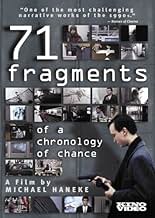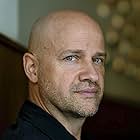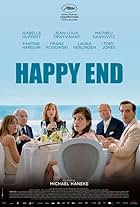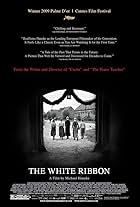71 frammenti di una cronologia del caso
Titolo originale: 71 Fragmente einer Chronologie des Zufalls
VALUTAZIONE IMDb
7,2/10
9039
LA TUA VALUTAZIONE
Settantuno scene che ruotano attorno a un recente immigrato.Settantuno scene che ruotano attorno a un recente immigrato.Settantuno scene che ruotano attorno a un recente immigrato.
- Premi
- 4 vittorie
Michael Jackson
- Self
- (filmato d'archivio)
- (non citato nei titoli originali)
Trama
Lo sapevi?
- QuizFilm debut of Sebastian Stan.
- BlooperWhen Tomek (Otto Grünmandl) makes himself dinner, around the 20 minutes mark, there's a mirror in the background that reflects the boom mic.
- ConnessioniFeatured in Mein Leben: Michael Haneke (2009)
Recensione in evidenza
Before Austrian film director Michael Haneke got well-recognized and appreciated in the international film circuit with such films as "Code Unknown", "Time of the Wolf" and "The Piano Teacher" (all of which were made in France and shown in Cannes), he already made his mark with a number of films made in his native Austria, one of which is this film called "71 Fragments of a Chronology of Chance"(1994). This work is the third installment in the director's "glaciation trilogy" (the other two being "The Seventh Continent" and "Benny's Video"), thus called because of the central theme of the fine line between barbarism and civility in modern urban life being completely, hopelessly blurred. The "barrier" has been broken, so to speak.
As the title suggests, the film consists of 71 "fragments" or vignettes, seemingly random, unrelated and mundane, of various characters going through the motions and vagaries of daily existence in urban Austria. But one can sense that this only seems to be so, as the film's prologue suggests that this is the event that will loom over the succeeding "fragments". And that is, the 1993 Christmas Eve reckless shooting done by a 19-year-old student named only as Maximillian B. inside a bank and on the streets, before eventually shooting himselfone that is purportedly based on a real-life incident.
No explanations or back-stories are provided to the characters and their situations being shown "episodically" on the screen (a Romanian boy refugee, a bank delivery man, an old pensioner, a childless couple and, of course, the student himself). More often than not, a specific fragment is abruptly interrupted or ended by a black fade-out (an alienating technique Haneke once again utilized in the equally visceral and demanding "Code Unknown"). Some fragments happen for not more than a minute, while some last for as long as five or even eight minutes (notably the scene where the student practices ping-pong tennis facing an automated opponent and the scene where the old pensioner argues with his daughter over the phone, both of which vividly displaying a whole gamut of simmering emotions without ever resorting to histrionics). Even reinforcing the clinical, cold approachfor which Haneke is really knownis the utter lack of an accompanying soundtrack and the wordlessness of some scenes.
The sense of dread is punctuated by the ever-present television (as is the case in the two other films in the trilogy), from where a specific world news is being broadcast (like the ethnic war in Somalia and the child abuse charges against pop star Michael Jackson). This is as if to suggest that the looming event foreboded at the film's start is itself to become a subject of a TV news coverage which, albeit small in scale when compared to the news indicated above, is nevertheless not without a lasting cost to the human lives involved, physically, emotionally and psychologically. Having said this, how has the line separating civility and barbarism come to be completely violated in this thought-provoking film?
The trigger shooting perpetrated by the young student, which serves to be the film's denouement, appears to have been done for no apparent reason at all. It's senseless killing in its purest meaning (which arguably is the underlying essence of the middle-class family's suicide in "The Seventh Continent" and the teenage boy's videotaped murder of the girl in "Benny's Video"). And this is what makes the act all the more chilling. It's as if to suggest that such a self-destructive act is inherent in everyone of us, if not what makes up our essence, waiting only to be brought to the surface by a seemingly random and inconsequential spate of events (in "71 Fragments'" case, it's to be rooted in the student's lack of enough cash to pay for his car gas).
And when the "event" does finally happen, rather than to serve as an important food-for-thought, it's sadly reduced to no more than a piece of media sensation, regarded as the hot "news of the day", focusing more on "what" happened than on "why" did it happen. The alarming incident thus becomes another piece of media entertainment, to be savored by mass consumers who always crave for what is sensational and controversial, without ever thinking of its deep-rooted incitations and implications. (This is a thought which Haneke is to delve full-blown in "Funny Games", both the Austrian and American versions, though I really prefer the first one.)
If in Polish auteur Krzysztof Kieslowski's world, chance incidents and fateful encounters are all part of a grand design to convey deep layers of human emotional truths (like in the truly majestic "Three Colors" trilogy), in Haneke's (or at least in the world of "71 Fragments"), such randomness is to be put in order by an inherent barbarism that's only barely creeping out of the human psyche.
As the title suggests, the film consists of 71 "fragments" or vignettes, seemingly random, unrelated and mundane, of various characters going through the motions and vagaries of daily existence in urban Austria. But one can sense that this only seems to be so, as the film's prologue suggests that this is the event that will loom over the succeeding "fragments". And that is, the 1993 Christmas Eve reckless shooting done by a 19-year-old student named only as Maximillian B. inside a bank and on the streets, before eventually shooting himselfone that is purportedly based on a real-life incident.
No explanations or back-stories are provided to the characters and their situations being shown "episodically" on the screen (a Romanian boy refugee, a bank delivery man, an old pensioner, a childless couple and, of course, the student himself). More often than not, a specific fragment is abruptly interrupted or ended by a black fade-out (an alienating technique Haneke once again utilized in the equally visceral and demanding "Code Unknown"). Some fragments happen for not more than a minute, while some last for as long as five or even eight minutes (notably the scene where the student practices ping-pong tennis facing an automated opponent and the scene where the old pensioner argues with his daughter over the phone, both of which vividly displaying a whole gamut of simmering emotions without ever resorting to histrionics). Even reinforcing the clinical, cold approachfor which Haneke is really knownis the utter lack of an accompanying soundtrack and the wordlessness of some scenes.
The sense of dread is punctuated by the ever-present television (as is the case in the two other films in the trilogy), from where a specific world news is being broadcast (like the ethnic war in Somalia and the child abuse charges against pop star Michael Jackson). This is as if to suggest that the looming event foreboded at the film's start is itself to become a subject of a TV news coverage which, albeit small in scale when compared to the news indicated above, is nevertheless not without a lasting cost to the human lives involved, physically, emotionally and psychologically. Having said this, how has the line separating civility and barbarism come to be completely violated in this thought-provoking film?
The trigger shooting perpetrated by the young student, which serves to be the film's denouement, appears to have been done for no apparent reason at all. It's senseless killing in its purest meaning (which arguably is the underlying essence of the middle-class family's suicide in "The Seventh Continent" and the teenage boy's videotaped murder of the girl in "Benny's Video"). And this is what makes the act all the more chilling. It's as if to suggest that such a self-destructive act is inherent in everyone of us, if not what makes up our essence, waiting only to be brought to the surface by a seemingly random and inconsequential spate of events (in "71 Fragments'" case, it's to be rooted in the student's lack of enough cash to pay for his car gas).
And when the "event" does finally happen, rather than to serve as an important food-for-thought, it's sadly reduced to no more than a piece of media sensation, regarded as the hot "news of the day", focusing more on "what" happened than on "why" did it happen. The alarming incident thus becomes another piece of media entertainment, to be savored by mass consumers who always crave for what is sensational and controversial, without ever thinking of its deep-rooted incitations and implications. (This is a thought which Haneke is to delve full-blown in "Funny Games", both the Austrian and American versions, though I really prefer the first one.)
If in Polish auteur Krzysztof Kieslowski's world, chance incidents and fateful encounters are all part of a grand design to convey deep layers of human emotional truths (like in the truly majestic "Three Colors" trilogy), in Haneke's (or at least in the world of "71 Fragments"), such randomness is to be put in order by an inherent barbarism that's only barely creeping out of the human psyche.
- renelsonantonius
- 24 set 2008
- Permalink
I più visti
Accedi per valutare e creare un elenco di titoli salvati per ottenere consigli personalizzati
- How long is 71 Fragments of a Chronology of Chance?Powered by Alexa
Dettagli
- Data di uscita
- Paesi di origine
- Lingue
- Celebre anche come
- 71 Fragments of a Chronology of Chance
- Luoghi delle riprese
- Aziende produttrici
- Vedi altri crediti dell’azienda su IMDbPro
- Tempo di esecuzione1 ora 40 minuti
- Colore
- Proporzioni
- 1.66 : 1
Contribuisci a questa pagina
Suggerisci una modifica o aggiungi i contenuti mancanti

Divario superiore
By what name was 71 frammenti di una cronologia del caso (1994) officially released in India in English?
Rispondi

























